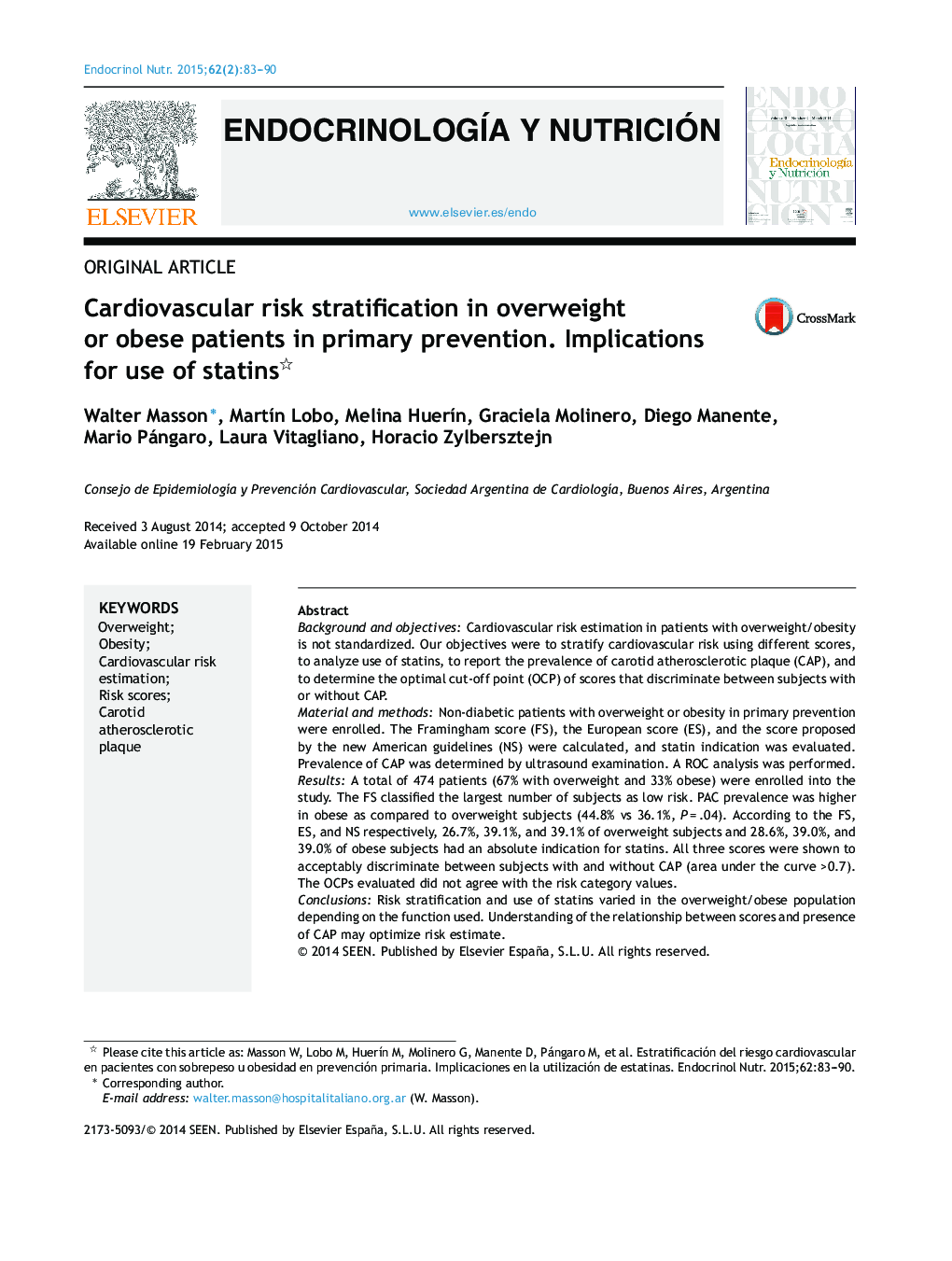| Article ID | Journal | Published Year | Pages | File Type |
|---|---|---|---|---|
| 3266987 | Endocrinología y Nutrición (English Edition) | 2015 | 8 Pages |
Background and objectivesCardiovascular risk estimation in patients with overweight/obesity is not standardized. Our objectives were to stratify cardiovascular risk using different scores, to analyze use of statins, to report the prevalence of carotid atherosclerotic plaque (CAP), and to determine the optimal cut-off point (OCP) of scores that discriminate between subjects with or without CAP.Material and methodsNon-diabetic patients with overweight or obesity in primary prevention were enrolled. The Framingham score (FS), the European score (ES), and the score proposed by the new American guidelines (NS) were calculated, and statin indication was evaluated. Prevalence of CAP was determined by ultrasound examination. A ROC analysis was performed.ResultsA total of 474 patients (67% with overweight and 33% obese) were enrolled into the study. The FS classified the largest number of subjects as low risk. PAC prevalence was higher in obese as compared to overweight subjects (44.8% vs 36.1%, P = .04). According to the FS, ES, and NS respectively, 26.7%, 39.1%, and 39.1% of overweight subjects and 28.6%, 39.0%, and 39.0% of obese subjects had an absolute indication for statins. All three scores were shown to acceptably discriminate between subjects with and without CAP (area under the curve >0.7). The OCPs evaluated did not agree with the risk category values.ConclusionsRisk stratification and use of statins varied in the overweight/obese population depending on the function used. Understanding of the relationship between scores and presence of CAP may optimize risk estimate.
ResumenAntecedentes y objetivosLa estimación del riesgo cardiovascular en pacientes con sobrepeso/obesidad no está estandarizada. Nuestros objetivos fueron: estratificar el riesgo cardiovascular mediante distintos puntajes, analizar la indicación de estatinas, describir la prevalencia de placa aterosclerótica carotídea (PAC) y determinar el punto de corte óptimo (PCO) de los puntajes que discriminen entre sujetos con o sin PAC.Material y métodosIncluimos a pacientes no diabéticos con sobrepeso u obesidad en prevención primaria. Calculamos los puntajes de Framingham (PF) y europeo (PE), y el propuesto por las nuevas guías norteamericanas (NP), evaluando la indicación de estatinas. Determinamos la prevalencia de PAC mediante ultrasonido. Realizamos un análisis ROC.ResultadosSe incluyó a 474 pacientes (67% con sobrepeso y 33% obesos). El PF fue el que más sujetos clasificó como «bajo riesgo». La prevalencia de PAC fue mayor en los obesos en comparación con los sujetos con sobrepeso (44.8% vs. 36.1%, p = 0,04). Basándose en el PF, PE y NP, el 26,7, el 39,1 y el 39,1% de los sujetos con sobrepeso y el 28,6, el 39,0 y el 39,0% de los obesos tenían indicación absoluta de estatinas. Los 3 puntajes mostraron discriminar aceptablemente entre sujetos con o sin PAC (área bajo la curva >0,7). Los PCO evaluados no necesariamente coincidieron con los valores que determinan las categorías de riesgo.ConclusionesEn esta población con sobrepeso/obesidad, la estratificación de riesgo y la indicación de estatinas variaron según la función utilizada. Conocer la relación entre los puntajes y la presencia de PAC podría optimizar la estimación de riesgo.
